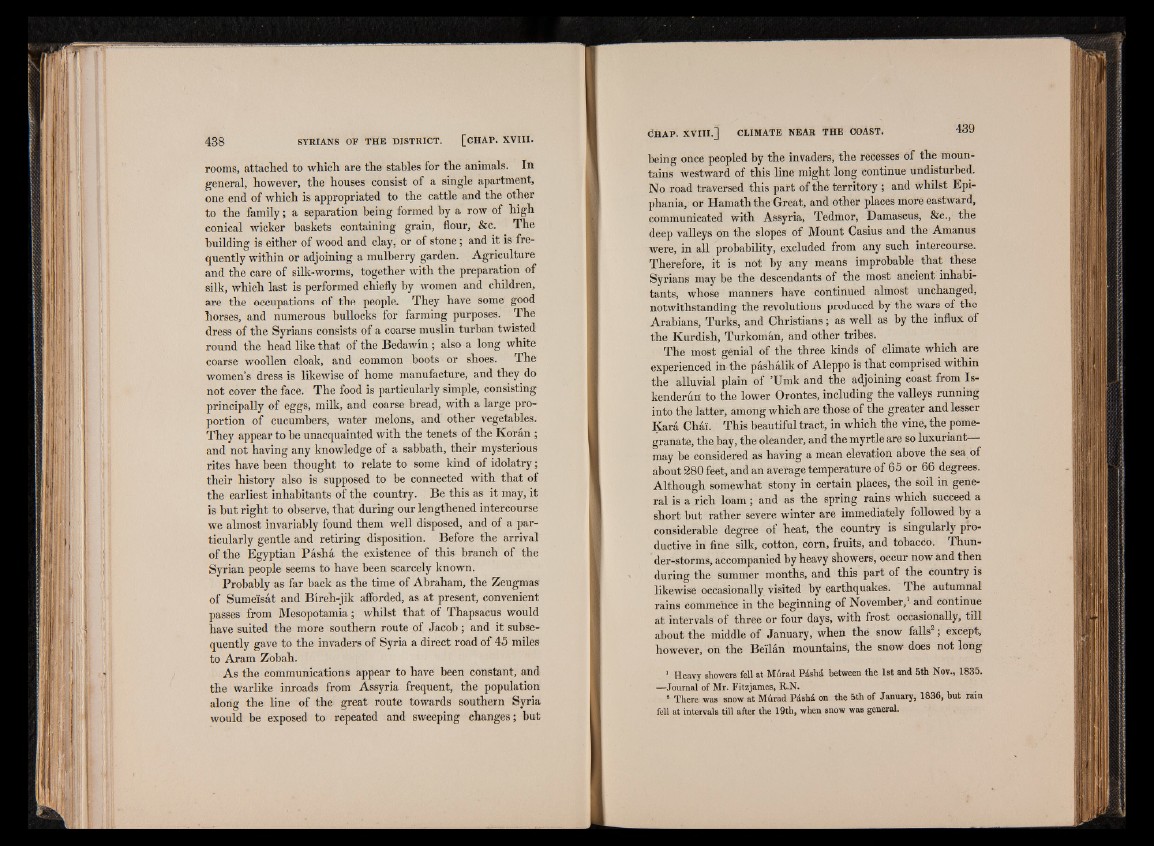
rooms, attached to which are the stables for the animals. In
general, however, the houses consist of a single apartment,
one end of which is appropriated to the cattle and the other
to the family; a separation being formed by a row of high
conical wicker baskets containing grain, flour, &c. The
building is either of wood and clay, or of stone; and it is frequently
within or adjoining a mulberry garden. Agriculture
and the care of silk-worms, together with the preparation of
silk, which last is performed chiefly by women and children,
are the occupations of the people. They have some good
horses, and numerous bullocks for farming purposes. The
dress of the Syrians consists of a coarse muslin turban twisted
round the head like that of the Bedawin; also a long white
coarse woollen cloak, and common boots or shoes. The
women’s dress is likewise of home manufacture, and they do
not cover the face. The food is particularly simple, consisting
principally of eggs, milk, and coarse bread, with a large proportion
of cucumbers, water melons, and other vegetables.
They appear to be unacquainted with the tenets of the Koran ;
and not having any knowledge of a sabbath, their mysterious
rites have been thought to relate to some kind of idolatry;
their history also is supposed to be connected with that of
the earliest inhabitants of the country. Be this as it may, it
is but right to observe, that during our lengthened intercourse
we almost invariably found them well disposed, and of a particularly
gentle and retiring disposition. Before the arrival
of the Egyptian Pasha the existence of this branch of the
Syrian people seems to have been scarcely known.
Probably as far back as the time of Abraham, the Zeugmas
of Sumeisat and Bireh-jik afforded, as at present, convenient
passes from Mesopotamia; whilst that of Thapsacus would
have suited the more southern route of Jacob ; and it subsequently
gave to the invaders of Syria a direct road of 45 miles
to Aram Zobah.
As the communications appear to have been constant, and
the warlike inroads from Assyria frequent, the population
along the line of the great route towards southern Syria
would be exposed to repeated and sweeping changes; but
being once peopled by the invaders, the recesses of the mountains
westward of this line might long continue undisturbed.
No road traversed this part of the territory ; and whilst Epi-
phania, or Hamath the Great, and other places more eastward,
communicated with Assyria, Tedmor, Damascus, &c., the
deep valleys on the slopes of Mount Casius and the Amanus
were, in all probability, excluded from any such intercourse.
Therefore, it is not by any means improbable that these
Syrians may be the descendants of the most ancient inhabitants,
whose manners have continued almost unchanged,
notwithstanding the revolutions produced by the wars of the
Arabians, Turks, and Christiaiis ; as well as by the influx of
the Kurdish, Turkoman, and other tribes;
The most genial of the three kinds of climate which are
experienced in the pâshâlik of Aleppo is that comprised within
thè alluvial plain of ’Umk and the adjoining coast from Is-
kenderun to the lower Orontes, including the valleys running
into the latter, among which are those of the greater and lesser
Kara Chai. This beautiful tract, in which the vine, the pomegranate,
the bay, the oleander, and the myrtle are so luxuriant—
may be considered as having a mean elevation above the sea of
about 2 8 0 feet, and an average temperature of 65 or 66 degrees.
Although somewhat Stony in certain places, the soil in general
is a rich loam ; and as the spring rains which Succeed a
short but rather severe winter are immediately followed by a
Considerable degree oi heat, the country is singularly productive
in fine silk, cotton, corn, fruits, and tobacco. Thunder
storms, accompanied by heavy showers, occur now and then
during the summer months, and this part of the country is
likewise occasionally visited by earthquakes. The autumnal
rains commence in the beginning of November,1 and continue
at intervals of three or four days, with frost occasionally, till
about the middle of January, when thé snow falls2 ; except,
however, on the Beïlan mountains, the snow does not long
1 Heavy showers fell at Miirad Pdshd between the 1st and 5th Nov., 1835.
—Journal of Mr. Fitzjames, R.N.
2 There was snow at Murad Pdshd on the 5th of January, 1836, but rain
fell at intervals till after the 19th, when snow was general.